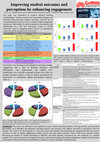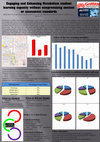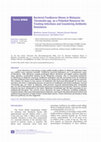Conference Presentations by Ian Cock

Introduction. This paper reports the results of a case study on the use of reflective practice to... more Introduction. This paper reports the results of a case study on the use of reflective practice to enhance student engagement and student success in a first year biosciences course at Griffith University.
Aims. The study was undertaken to evaluate different teaching methodologies, learning activities and assessment strategies and determine those that gave positive outcomes, with the aim of incorporating them into the course to enhance student engagement and success. Specifically, the study examined the development and modification of a course aimed at engaging student interest in contemporary issues and current research in the biosciences.
Methods. Through the course of the study, the curriculum was developed and adapted to maximise student engagement and a suite of teaching modalities and philosophies were implemented and trialled. All teaching methods and activities trialled have received recent interest and all are purported to enhance student engagement. Each modification was critically examined in terms of its effect on student outcomes and on student perceptions (as determined via anonymous student questionaires).
Results. The course Topics in Biosciences (1003 BPS) at Griffith University, Australia was developed with the aim of engaging first year university students in the biosciences and thereby aid in increasing student retention rates and the transition of students to the second year of their studies. The course incorporated learning activities that have previously been shown to have positive effects on student engagement including collaborative group work, writing to learn activities as well as oral and written presentations. Incorporation of other teaching practices which have been established to positively influence student engagement and success such as clear and rapid feedback on assessment, directed approaches to group assignment and in lecture activities to engage student participation were all included. The result was a well-rounded course that achieved good student engagement and success rates and that was positively received by the student cohort.
Discussion. Results from this study strongly indicate a positive influence for incorporating teaching activities that encourage active learning and engagement (such as in-lecture quizzes, collaborative group presentations, writing-to-learn activities) into the course structure. A clear correlation between incorporating these teaching practices with both student outcomes and student perceptions with the course was noted.

Introduction. Metabolism at Griffith University is a content heavy second year course with which ... more Introduction. Metabolism at Griffith University is a content heavy second year course with which students traditionally have struggled. It has traditionally suffered from an unacceptably high failure rate (>20%) in our school. Student perceptions of the difficulty of the course lead to disengagement prior to starting, with students not having acquired appropriate study techniques that would enhance their capacity to succeed.
Aims. This study aimed to develop a new teaching modality for the metabolism course and to monitor its effectiveness at increasing student outcomes and satisfaction, without compromising content or assessment standards.
Methods. Remodelling of the course in information sequence presentation and in presentation style occurred over several years. Content sequence changes ensured an understanding of key metabolic pathways followed by regulatory influences and disease states. The new format has a three week cycle that begins with traditional lectures but follows with workshops designed to cement core concepts and develop global cognitive comprehension. The cycle was designed to enable students to approach the study of this subject in a scaffolded manner that promotes engagement with materials and facilitates their overall capacity to learn in a deep manner.
Results. This strategy resulted in consistent reduction in the fail rate of approximately 10% (2008-2011) without compromising the standard of assessment. Students were guided to develop better self-efficacy and independent learning skills. Evidence of subject mastery is demonstrated by higher pass rates and also a shift to higher numbers of distinction and high distinction.
Discussion. Our scaffolded approach to teaching metabolism succeeded in significantly increasing student comprehension and satisfaction without compromising content or assessment standards.

Metabolism is a content heavy second year course with which students traditionally struggle and h... more Metabolism is a content heavy second year course with which students traditionally struggle and has suffered from an unacceptably high failure rate (>20%, 2004-2006) in our school. Student perceptions of the difficulty of the course lead to disengagement prior to starting with students not having acquired appropriate study techniques that would enhance their capacity to succeed.
Remodelling of the course in information sequence presentation (2007) and in presentation style (2009) occurred. Content sequence ensured an understanding of key metabolic pathways followed by regulatory influences and disease states. The new format has a three week cycle that begins with traditional lectures but follows with workshops designed to cement core concepts and develop global cognitive comprehension. The cycle was designed to enable students to approach the study of this subject in a scaffolded manner that promotes engagement with materials and facilitates their overall capacity to learn in a deep manner.
This strategy resulted in consistent reduction in the fail rate of approximately 10% (2008-2011) without compromising standard of assessment. Students were guided to develop better self-efficacy and independent learning skills. Evidence of subject mastery is demonstrated by higher pass rates and also a shift to higher numbers of distinction and high distinction.
Engaging and enhancing metabolism student learning capacity without “dumbing down” content or as... more Engaging and enhancing metabolism student learning capacity without “dumbing down” content or assessment standards – a scaffolded approach to the development of collaborative and independent learning behaviours.
Papers by Ian Cock
Marine and Freshwater Research, 2008

The Malaysian Journal of Medical Science, Apr 18, 2023
Acute diarrhoea is becoming a major public health problem in Malaysia, with more than 13.5 millio... more Acute diarrhoea is becoming a major public health problem in Malaysia, with more than 13.5 million cases reported annually. Foodborne bacterial pathogens are a predominant cause of diarrhoea, with infections causing prolonged illness durations and higher patient mortality rates, placing a tremendous burden on the Malaysian economy. Due to increasing incidences of diarrhoea in Malaysia caused by foodborne pathogens and the increasing levels of resistance towards antibiotics from many different classes, new drugs and/or therapies are urgently required. The evidence for plants as new sources of antibiotics has increased dramatically in recent years and there has been a substantial increase in interest in traditional and herbal medicines. Several Terminalia spp. are native to Malaysia, with previous research demonstrating that Terminalia spp. are rich in therapeutic phytochemicals and possess antibacterial properties. However, limited research has been conducted on the native Malaysian Terminalia spp. for their potential as new antibacterial therapies. The current review discusses the types of bacteria, including antibioticresistant strains, that cause food poisoning in Malaysia, and reports the phytochemical content and antibacterial properties of eight of these useful plant species. Future directions pertaining to drug discovery pathways are also suggested.
Pharmacognosy Communications, Oct 29, 2018
BEMS reports, Dec 20, 2016
Journal of Integrative Medicine, Jul 1, 2019
Apple Academic Press eBooks, Jul 4, 2018
Plants have been used as therapeutic agents since the start of civilization. In many developing c... more Plants have been used as therapeutic agents since the start of civilization. In many developing countries, herbal medicinal systems remain important in the treatment of many ailments. Ayuvedic medicine is still commonly

Introduction. Tasmannia lanceolata (TL) is an endemic Australian plant, long used as a food and a... more Introduction. Tasmannia lanceolata (TL) is an endemic Australian plant, long used as a food and a medicine by Indigenous Australians. The medicinal bioactivities of this plant are poorly studied. Methods. TL extracts were prepared with various solvents, dried and then re-suspended in water. Antibacterial activity of these preparations was determined by growth inhibition against a panel of pathogenic bacteria and fungi. Toxicity (LC50) was assessed by the Artemia franciscanna (brine shrimp) nauplii bioassay. Results. All extracts inhibited the growth of 50% of the bacteria tested and 100% of the fungi via disc diffusion assay. The ethyl acetate and hexane extracts proved to have the greater antibacterial activity with lower Minimum Inhibition Concentration (MIC) values. In comparison to the other extracts, the chloroform extract had a lower bacterial inhibitory activity with higher MIC’s. All TL extracts were equally effective against Gram-positive (50 %) and Gram-negative bacteria (50 %), suggesting the phytochemical components are effective in penetrating the Gram-negative outer membrane lipopolysaccharide layer. The water, hexane and ethyl acetate extracts were non toxic, with no significant increase in mortality induction. The methanol extract toxicity was unable to be determined, at the concentration tested. The chloroform extract displayed low toxicity in the Artemia fransiscana bioassay (LC50 >1500 µg/ml). Conclusions. The low toxicity of the TL extracts and their inhibitory bioactivity against a range of bacteria validate traditional Aboriginal usage of the Tasmannia lanceolata and indicates its medicinal potential.
Pharmacognosy Communications, May 5, 2023
Pharmacognosy Communications, May 5, 2023
Pharmacognosy Communications, May 5, 2023
Pharmacognosy Communications, Jan 24, 2023
Pharmacognosy Communications, Dec 24, 2021

Elsevier eBooks, 2021
Abstract Terminalia spp. have long been used medicinally in traditional healing systems, includin... more Abstract Terminalia spp. have long been used medicinally in traditional healing systems, including for the treatment of cancers. Several species, including T. chebula, T. bellerica, and T. ferdinandiana, have been reported to have potent antiproliferative activities against multiple cell lines. A number of anticancer mechanisms have been studied, with the induction of apoptosis consistently reported. Several of those studies correlated the anticancer properties of these plants with their high antioxidant and tannin contents. Notably, many of these components have potent anticancer properties when tested alone, indicating that they may contribute to the anticancer properties of this genus. Recent studies have also identified other notable compounds (including the combretastatins and other stilbenes) that have potent anticancer activity and it is likely that these may also contribute to the anticancer properties of Terminalia spp. This chapter reviews the current knowledge regarding the phytochemistry and anticancer properties of this genus with the aim of stimulating and focusing further study in this field.











Uploads
Conference Presentations by Ian Cock
Aims. The study was undertaken to evaluate different teaching methodologies, learning activities and assessment strategies and determine those that gave positive outcomes, with the aim of incorporating them into the course to enhance student engagement and success. Specifically, the study examined the development and modification of a course aimed at engaging student interest in contemporary issues and current research in the biosciences.
Methods. Through the course of the study, the curriculum was developed and adapted to maximise student engagement and a suite of teaching modalities and philosophies were implemented and trialled. All teaching methods and activities trialled have received recent interest and all are purported to enhance student engagement. Each modification was critically examined in terms of its effect on student outcomes and on student perceptions (as determined via anonymous student questionaires).
Results. The course Topics in Biosciences (1003 BPS) at Griffith University, Australia was developed with the aim of engaging first year university students in the biosciences and thereby aid in increasing student retention rates and the transition of students to the second year of their studies. The course incorporated learning activities that have previously been shown to have positive effects on student engagement including collaborative group work, writing to learn activities as well as oral and written presentations. Incorporation of other teaching practices which have been established to positively influence student engagement and success such as clear and rapid feedback on assessment, directed approaches to group assignment and in lecture activities to engage student participation were all included. The result was a well-rounded course that achieved good student engagement and success rates and that was positively received by the student cohort.
Discussion. Results from this study strongly indicate a positive influence for incorporating teaching activities that encourage active learning and engagement (such as in-lecture quizzes, collaborative group presentations, writing-to-learn activities) into the course structure. A clear correlation between incorporating these teaching practices with both student outcomes and student perceptions with the course was noted.
Aims. This study aimed to develop a new teaching modality for the metabolism course and to monitor its effectiveness at increasing student outcomes and satisfaction, without compromising content or assessment standards.
Methods. Remodelling of the course in information sequence presentation and in presentation style occurred over several years. Content sequence changes ensured an understanding of key metabolic pathways followed by regulatory influences and disease states. The new format has a three week cycle that begins with traditional lectures but follows with workshops designed to cement core concepts and develop global cognitive comprehension. The cycle was designed to enable students to approach the study of this subject in a scaffolded manner that promotes engagement with materials and facilitates their overall capacity to learn in a deep manner.
Results. This strategy resulted in consistent reduction in the fail rate of approximately 10% (2008-2011) without compromising the standard of assessment. Students were guided to develop better self-efficacy and independent learning skills. Evidence of subject mastery is demonstrated by higher pass rates and also a shift to higher numbers of distinction and high distinction.
Discussion. Our scaffolded approach to teaching metabolism succeeded in significantly increasing student comprehension and satisfaction without compromising content or assessment standards.
Remodelling of the course in information sequence presentation (2007) and in presentation style (2009) occurred. Content sequence ensured an understanding of key metabolic pathways followed by regulatory influences and disease states. The new format has a three week cycle that begins with traditional lectures but follows with workshops designed to cement core concepts and develop global cognitive comprehension. The cycle was designed to enable students to approach the study of this subject in a scaffolded manner that promotes engagement with materials and facilitates their overall capacity to learn in a deep manner.
This strategy resulted in consistent reduction in the fail rate of approximately 10% (2008-2011) without compromising standard of assessment. Students were guided to develop better self-efficacy and independent learning skills. Evidence of subject mastery is demonstrated by higher pass rates and also a shift to higher numbers of distinction and high distinction.
Papers by Ian Cock
Aims. The study was undertaken to evaluate different teaching methodologies, learning activities and assessment strategies and determine those that gave positive outcomes, with the aim of incorporating them into the course to enhance student engagement and success. Specifically, the study examined the development and modification of a course aimed at engaging student interest in contemporary issues and current research in the biosciences.
Methods. Through the course of the study, the curriculum was developed and adapted to maximise student engagement and a suite of teaching modalities and philosophies were implemented and trialled. All teaching methods and activities trialled have received recent interest and all are purported to enhance student engagement. Each modification was critically examined in terms of its effect on student outcomes and on student perceptions (as determined via anonymous student questionaires).
Results. The course Topics in Biosciences (1003 BPS) at Griffith University, Australia was developed with the aim of engaging first year university students in the biosciences and thereby aid in increasing student retention rates and the transition of students to the second year of their studies. The course incorporated learning activities that have previously been shown to have positive effects on student engagement including collaborative group work, writing to learn activities as well as oral and written presentations. Incorporation of other teaching practices which have been established to positively influence student engagement and success such as clear and rapid feedback on assessment, directed approaches to group assignment and in lecture activities to engage student participation were all included. The result was a well-rounded course that achieved good student engagement and success rates and that was positively received by the student cohort.
Discussion. Results from this study strongly indicate a positive influence for incorporating teaching activities that encourage active learning and engagement (such as in-lecture quizzes, collaborative group presentations, writing-to-learn activities) into the course structure. A clear correlation between incorporating these teaching practices with both student outcomes and student perceptions with the course was noted.
Aims. This study aimed to develop a new teaching modality for the metabolism course and to monitor its effectiveness at increasing student outcomes and satisfaction, without compromising content or assessment standards.
Methods. Remodelling of the course in information sequence presentation and in presentation style occurred over several years. Content sequence changes ensured an understanding of key metabolic pathways followed by regulatory influences and disease states. The new format has a three week cycle that begins with traditional lectures but follows with workshops designed to cement core concepts and develop global cognitive comprehension. The cycle was designed to enable students to approach the study of this subject in a scaffolded manner that promotes engagement with materials and facilitates their overall capacity to learn in a deep manner.
Results. This strategy resulted in consistent reduction in the fail rate of approximately 10% (2008-2011) without compromising the standard of assessment. Students were guided to develop better self-efficacy and independent learning skills. Evidence of subject mastery is demonstrated by higher pass rates and also a shift to higher numbers of distinction and high distinction.
Discussion. Our scaffolded approach to teaching metabolism succeeded in significantly increasing student comprehension and satisfaction without compromising content or assessment standards.
Remodelling of the course in information sequence presentation (2007) and in presentation style (2009) occurred. Content sequence ensured an understanding of key metabolic pathways followed by regulatory influences and disease states. The new format has a three week cycle that begins with traditional lectures but follows with workshops designed to cement core concepts and develop global cognitive comprehension. The cycle was designed to enable students to approach the study of this subject in a scaffolded manner that promotes engagement with materials and facilitates their overall capacity to learn in a deep manner.
This strategy resulted in consistent reduction in the fail rate of approximately 10% (2008-2011) without compromising standard of assessment. Students were guided to develop better self-efficacy and independent learning skills. Evidence of subject mastery is demonstrated by higher pass rates and also a shift to higher numbers of distinction and high distinction.